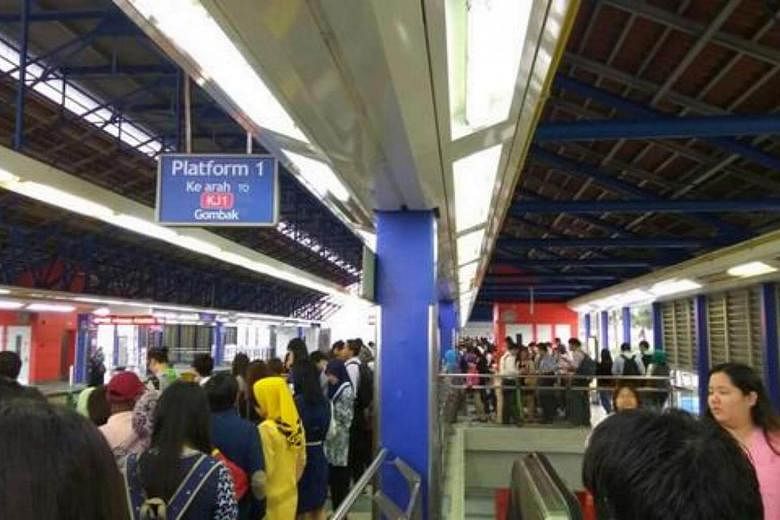Brian Martin
The Star/Asia News Network
The irony wasn't lost.
MRT Corp intended to showcase its multibillion train operations to a group of uniformed personnel on Wednesday (Sept 7). These emergency response officers - from the police, the Fire and Rescue Department and various medical services - were to have a first hand look at operations as well as take an MRT ride.
Unfortunately, they were all left disappointed when it was announced that the train ride had been cancelled, ostensibly due to a "driver error" the previous night.
This trial ride cancellation happened on the same day that the LRT line experienced a power cut leading to disruptions and chaotic scenes at a number of LRT stations in Petaling Jaya and Kuala Lumpur. The very same day.
I am in no way suggesting that both these incidents were connected: After all, the MRT disruption appeared to be an isolated incident.
In fact, last week when the Prime Minister was given a joy ride on the new line and visited a couple of MRT stations, everything went like clockwork.
My concern is that once MRT Corp is done with its rigorous testing process and the first phase of the MRT line from Sungai Buloh to Semantan is commissioned in mid-December, the entire operations will be handed over to Prasarana Malaysia Bhd via its subsidiary Rapid Rail Sdn Bhd, the operator of the entire LRT line.
This spanking new, multibillion ringgit MRT line is going to be Malaysia's pride. We need to ensure that what happened with the six-hour LRT disruption isn't repeated here.
The LRT lines have experienced delays before, but Wednesday's incident affected an estimated 100,000 commuters.
The disruption at the Kelana Jaya line occurred during peak hours and had a domino effect on the other stations. Stranded passengers took to Facebook and other social media tools to post pictures and vent their frustration.
Bank officer Priscilla Gomez, a frequent LRT user, has had to put up with delays in the past: "This was by far the worst. Communication to passengers was so bad. My question is, if it was power failure, doesn't Rapid Rail have a back-up plan?"
Another Facebook user posted: "What are you doing to avoid a repeat breakdown the next time it rains?"
The LRT and its complementary service, the monorail lines, have become the de facto mode of transport for an estimated 250,000 commuters daily.
Any disruption to this service is bound to have a knock-on effect on the traffic situation in PJ and especially Kuala Lumpur.
City Hall's recent move to raise parking fees in the city was designed to encourage commuters to use public transport. On the face of it, this makes sense.
A one-way trip, for example, from Taman Jaya to KLCC costs RM3.60 (S$1.20), whereas if you were to drive, the petrol and toll cost alone will almost double this, without including parking charges.
However, many people are still reluctant to use the LRT because of overcrowding and delays in running the trains. Wednesday's fiasco will not have encouraged them to change their minds.
Back to the MRT. As mentioned, the first phase will be operational in mid-December, from Sungai Buloh to Semantan. Phase two from Semantan to Kajang opens in mid-2017.
I've been a strong proponent of the MRT and I believe it will be a game changer as far as alleviating public transportation woes in the city, much like Bangkok's BTS proved when it first opened in 2000.
The MRT's four-car electric trains have a maximum load of 1,200 passengers and when fully operational, will run from Sungai Buloh to Kajang, a distance of 51 km (almost 10km underground).
The line will have 31 stations along its route.
What I'm really excited about is the integration of the MRT with KL Sentral - our capital's transportation hub. This will happen via a connection from the MRT station in Muzium Negara to KL Sentral.
It would mean leaving my car at my neighbourhood station in Taman Tun Dr Ismail or at my office station in Phileo Damansara and having the freedom to get to numerous parts of the city via the MRT and its connections.
To be fair, MRT Corp appears to have done a great job so far. Aside from the trial run glitch, I was impressed with the briefing by its senior management team to the emergency response agencies at its Sungai Buloh depot - incidentally, the largest railway depot in South-East Asia.
The operations control centre (OCC), the nerve centre of MRT operations, in particular, was very impressive. Easily the size of a football field, there will eventually be three OCCs for the three MRT lines.
MRT Corp intends to use the next three months for trial operations and this means you will see the electric trains running even more frequently.
The stations are virtually ready, but the trains need to have more trial runs to ensure Wednesday's glitch does not re-occur once the MRT opens its doors to the public.
Come December, the writer intends to leave his car at home and take the short MRT ride to Surian station, close to various shopping centres, currently congested with heavy traffic.

